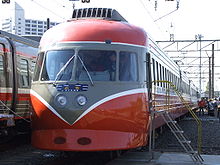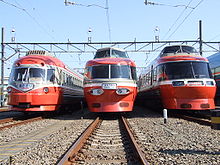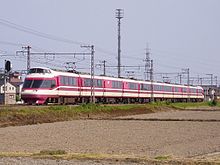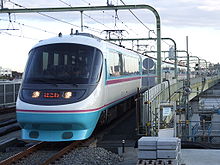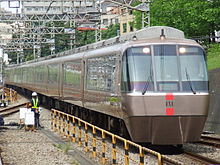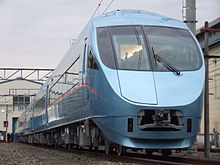- Romancecar
-
The Romancecar (ロマンスカー Romansukā) is Odakyu Electric Railway's name for its limited express luxury tourist services south-west of Tokyo, to mountain resorts such as Gotenba and Hakone, and beaches such as Numazu and Enoshima. Service started in 1957 with the 3000 series SE trainset, it broke the world speed record (145 km/h/90 mph) for a narrow gauge train. This record gave impetus for the design of the first Shinkansen, the 0 Series. The 50th anniversary of the Romancecar's narrow gauge world speed record was celebrated September 28, 2007.[1] Some of the latest designs incorporate regenerative braking.
Contents
Name origin
The name comes from romance seats, two-person seats without separating armrests when one-person seats were a norm. Some Romancecars are equipped with standard seats featuring armrests. Other railroad companies also used "romance cars" or "romance seats" (a Japanese portmanteau for "loveseat") for their special accommodation passenger cars, but Odakyū holds the trademark for the term "Romancecar".
Service
Bento meal with food in model train onboard VSE train
Odakyū currently operates the following Romancecar services:
- Hakone and Super Hakone service between Shinjuku and Hakone Yumoto (on Hakone Tozan Line, terminal station for visiting Hakone mountains and springs)
- Metro Hakone service between Hakone-Yumoto and Kita-Senju (in north-east of Tokyo) (direct through service to the Tokyo Metro Chiyoda Line from Yoyogi-Uehara)
- Enoshima service between Shinjuku and Katase Enoshima (in Fujisawa, Kanagawa
- Asagiri service between Shinjuku and Numazu on Central Japan Railway Company Gotenba Line (direct through service to this line near Matsuda Station, a station parallel to Shin-Matsuda Station)[clarification needed]
- Sagami service between Shinjuku and Odawara Station (in Odawara, Kanagawa)
- Homeway trains outbound from Shinjuku for Hakone-Yumoto, Katase-Enoshima and Karakida (in Tama New Town area, south-west of Tokyo) after 6 p.m.
- Metro Sagami service between Hon-Atsugi (in the west of the Atsugi city in Kanagawa Prefecture) and Kita-Senju (direct through service to the Tokyo Metro Chiyoda Line from Yoyogi-Uehara)
- Metro Homeway service between Karakida and Kita-Senju (direct through service to the Tokyo Metro Chiyoda Line from Yoyogi-Uehara)
- Bay Resort service between Hon-Atsugi and Shin-Kiba (south-east of Tokyo) (direct through service to the Tokyo Metro Chiyoda Line from Yoyogi-Uehara, and direct through service to the Tokyo Metro Yūrakuchō Line from Kasumigaseki)
These are classified as tokkyū (limited express) services, requiring limited express tickets and seat reservations. Bento meals are available on the train.
Trainset evolution
- Odakyū 3000 series SE: These pioneering rapid rail trains were introduced in 1957 and commonly used until 1968; one was used until 1991. They set the world speed record for narrow gauge track in September 1957 at 145 km/h and were an inspiration for the world's first high speed train, the Shinkansen. They later earned Japan's Blue Ribbon design award. The 8-car trains could seat 354 people.
- Odakyū 3100 series NSE: A taller, upgraded version of the 3000 series, it was used from 1963-1999. The 3100 series was the longest Romancecar in common service and gave it its distinctive look. The Nagoya Railroad Panorama Car design was based on the 3100 series. The 11-car trainset could seat 464 people, and had a maximum design speed of 170 km/h.
- Odakyū 7000 series LSE: Entering service in 1980, it has a 180-degree front view of scenery. It has seating for 464 people in 11 cars—identical to the 3100 series. It was manufactured by Kawasaki Heavy Industries.
- Odakyū 10000 series HiSE: Introduced in 1988, like its predecessor, 7000 series LSE, these two types are very closely related, and were once the top grade of Romancecar service, but with larger seats than the 7000. Like the VSE, the driver's compartment is elevated so that passengers at the front of the train have an unimpeded 180 degree view of the scenery. These trains are used for Hakone services, plying the same route as the VSE but stopping more often; the trip to Hakone takes about 90 minutes. Cabin attendants are available for food and drink service, except in the evening.
- Odakyū 20000 series RSE: Introduced in 1992, they are mainly used for Asagiri service to Gotemba, where they alternate with the very similar JR Central 371 series. They are the only Odakyū trains with first-class seating in "semi-compartments" on the upper deck of two bi-level cars in the center of each train. It is the first in the series to break from the traditional wine red color, being baby blue.
- Odakyū 30000 series EXE: Introduced in 1996, these currently operate most Romancecar services. Most are equipped with vending machines on board, and some also have cabin attendants. They are boxy and metallic bronze in color.
- Odakyū 50000 series VSE: Introduced in 2005, the white VSE is the newest and most comfortable Odakyū train, with the driver's compartment elevated over the cabin as with the HiSE. VSE trains are primarily used for Super Hakone services and have cabin attendants who bring food, drinks, and on-board shopping to each passenger's seat during the 80-minute run to Hakone. There are also two cars with café spaces, leading to the VSE's reputation as a "moving café" (走る喫茶室). There are seats for 358 people.
- Odakyū 60000 series MSE: The 60000 series entered service in March 2008 and was the first Romancecar to be used on through services on the Tokyo Metro Chiyoda Line.
References
- ^ "50年前の特急ロマンスカーが登場" (in Japanese). Asahi. 2007-10-03. http://www.asahi.com/komimi/TKY200709280266.html. Retrieved 2007-11-30.
Odakyu trainsets Romancecar 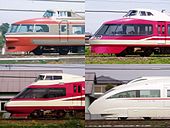
Commuter Categories:- Named passenger trains of Japan
- Odakyu Electric Railway
- Japan rail transport stubs
Wikimedia Foundation. 2010.


